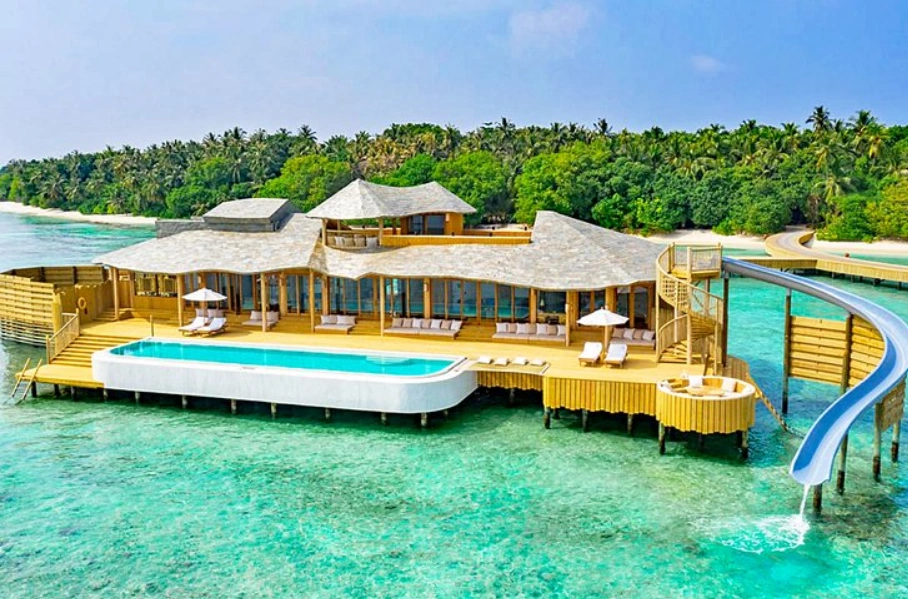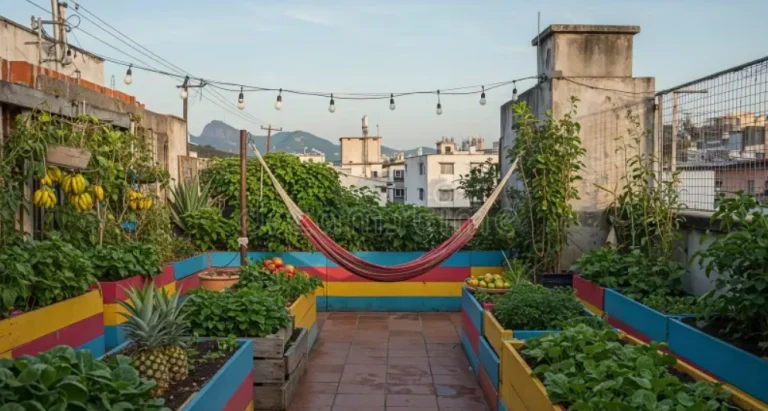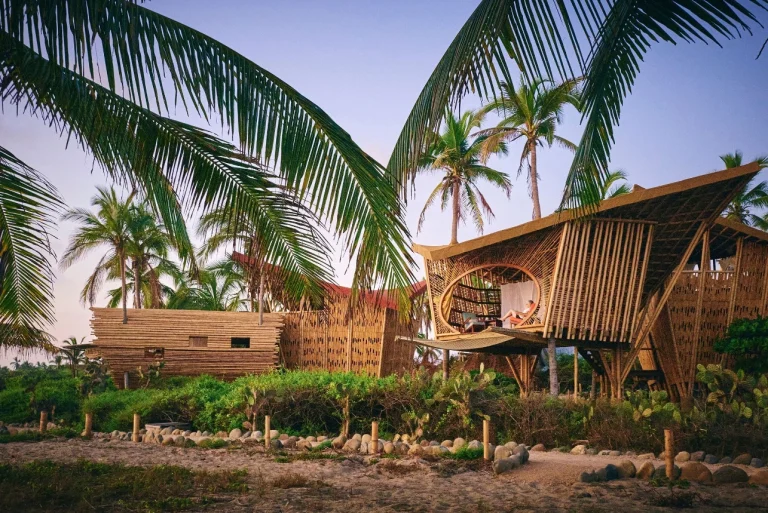Top Green Hotels and Resorts Worldwide: Sustainable Travel Picks
Waves lap gently against a bamboo villa perched on a Balinese hillside. Morning yoga unfolds with birdsong, your breakfast sourced from on-site gardens. No plastic in sight. Waste diverts to compost. This isn’t just a stay—it’s immersion in harmony with nature. Top green hotels and resorts worldwide elevate travel, blending luxury with low-impact living. These havens use solar arrays, rainwater harvest, and zero-waste kitchens to offset operations, letting guests unwind guilt-free while contributing to ecosystems. For eco-curious couples or families, this means restorative escapes that recharge body and planet, trimming your trip’s footprint by 50% through verified practices.
Why seek them out? Conventional spots guzzle energy—up to 10,000 liters water per room daily. Green gems cut that 70%, channeling savings into community funds or wildlife corridors. A night at a certified LEED resort might plant a tree per guest, sequestering your flight’s carbon. Benefits touch deeper: Wellness blooms in toxin-free spaces, local economies thrive via farm-to-table ties, and you return inspired—perhaps swapping single-use for reusables at home. In biodiversity hotspots like Costa Rica or Norway’s fjords, stays support rangers, yielding tangible conservation.
These aren’t rustic retreats. Solar-heated pools shimmer in Maldives bungalows; geothermal spas bubble in Icelandic lodges. Ideal for adventurers craving authenticity; luxury seekers find refined edges. Skip if budget caps $200/night—premium spots start higher. We curated from Global Sustainable Tourism Council audits and guest logs, spotlighting 10 standouts across continents. From bamboo utopias to glacial glampers, each weaves innovation with intimacy. Transition to the escapes redefining rest, where green isn’t gimmick—it’s grace.

Eco-Havens by Horizon: Standouts from Tropics to Tundras
Green stays span biomes, each tuned to locale. In Bali’s lush folds, Bambu Indah rises on stilts of sustainable bamboo, harvesting rainwater for infinity pools. Solar powers villas, waste composts to fertilize permaculture farms. Guests forage breakfasts, offsetting stays via reforestation—$50/night funds 10 trees. For wellness seekers, yoga decks overlook rice terraces, cutting stress while sequestering 2 tons CO2 yearly per room.
Shift to Ecuador’s cloud forests, where Mashpi Lodge perches amid 2,500 acres reserve. Cable cars glide through canopy, spotting rare birds; 98% energy from hydro and biomass. Rooms use recycled teak, linens organic. A night supports anti-poaching, yielding biodiversity boosts—guests track via apps. Transition to Kenya’s savannas, Mahali Mzuri tents dot Masai Mara, solar-charged with electric fences guarding wildlife. Starlit dinners feature bush-meat alternatives, offsetting safaris carbon-neutral.
These spots prioritize place—tropics revive, wilds inspire. Drawbacks? Remote access hikes travel emissions—offset flights first. For explorers, this means deeper connections: Local guides share lore, meals nourish sustainably.
Bamboo Bliss: Bambu Indah’s Riverside Retreat in Bali
Bambu Indah’s 18 villas climb hillsides, bamboo frames earthquake-proof. Solar arrays generate 80% power, greywater irrigates gardens yielding 90% produce.
River pools chill naturally, spa uses volcanic clay. Rates $250-600/night; funds tree-planting.
Con: Stairs challenge mobility—request ground levels. Suits adventurers; loungers seek flats.
Cloud Canopy: Mashpi Lodge’s Forest Immersion in Ecuador
Mashpi’s 22 rooms overlook mists, hydro turbines silent. Biodiversity lab shares sightings, 100% waste recycled.
Cable car tours spot 400 bird species, meals foraged. $800-1,200/night; supports rangers.
Minus: Rainy seasons muddy trails—pack boots. Ideal birders; dry-desert no.
Savanna Sanctuary: Mahali Mzuri’s Tent Tents in Kenya
Sir Richard Branson’s 14 tents blend luxury canvas, solar lanterns glow. Electric fences protect rhinos, kitchen sources 70% local.
Game drives dawn-dusk, stargazing decks. $1,500-2,500/night; offsets wildlife corridors.
Draw: Remote airstrip flights add carbon—choose overland. Best safari souls; city skip.
Continental Gems: From Fjords to Deserts, Green Stays Shine
Northern lights dance over Norwegian fjords at Six Senses Svart, the world’s first energy-positive resort. Floating on Arctic waters, it generates 20% surplus via solar-wind hybrids, feeding grids. Rooms use aerogel insulation, zero-plastic policies. Guests kayak with orcas, spa heated geothermally—$1,200/night funds ocean cleanups.
Pivot to Mexico’s Riviera Maya, Sandos Caracol Eco Resort sprawls 100 acres jungle, cenotes for swims. Solar powers 90% operations, turtle hatcheries release 10,000 yearly. All-inclusive meals organic, bikes replace cars—$300-500/night offsets reef protection.
In Chile’s Patagonia, Hotel Las Torres blends stone cabins amid Torres del Paine, wind turbines silent. Horse treks spot guanacos, kitchen forages berries—$600-1,000/night supports gaucho conservation.
These continental contrasts highlight adaptation—cold climes insulate, deserts conserve. Challenges: Seasonal closures in extremes—book shoulder months. For globetrotters, this yields variety: Arctic auroras. Mayan mysteries. Patagonian peaks.
Arctic Anchor: Six Senses Svart’s Floating Fjord Haven in Norway
Svart’s 94 rooms bob on water, solar-wind surplus 20%. Geothermal spas warm, kelp menus sustainable.
Kayak tours spot whales, $1,200/night funds fjord clean.
Con: Winter dark limits activities—summer peak. Suits northern lights; tropics no.
Cenote Sanctuary: Sandos Caracol’s Jungle Jewel in Mexico
Caracol’s 956 rooms thread vines, solar 90% clean. Cenote swims, turtle releases nightly.
Bikes roam, organic buffets. $300-500/night; reef guards.
Minus: Humidity clings—pack light. Best divers; dry pass.
Patagonian Peak: Hotel Las Torres’ Rugged Retreat in Chile
Torres’ 17 cabins hug peaks, wind silent. Horse safaris, berry feasts.
$600-1,000/night; gaucho preserves.
Draw: Winds whip—layer up. Ideal hikers; beaches skip.
Global Guardians: Community and Conservation in Green Stays
Green resorts rally locals. In the Maldives, Club Med Finolhu Villas trains islanders for jobs, solar desalinating water for 200 bungalows. Coral nurseries grow reefs, guests snorkel restorations—$800/night funds marine labs.
To Las Vegas’ ARIA Resort, LED lights slash 40% energy, water recycled for fountains. Vegan menus cut methane, EV chargers free—$250-400/night offsets Strip glow.
In Thailand’s Koh Samui, Banyan Tree uses elephant sanctuaries, no-ride policies. Spa herbs from gardens, 70% renewable—$500-800/night supports anti-poach.
These guardians extend impact—jobs empower, wildlife rebounds. Pitfalls: Overtourism strains—visit off-peak. For impact travelers, this means purpose: Reef revivals. Elephant ethics. Desert oases.
Maldives Marine: Club Med Finolhu’s Overwater Oasis
Finolhu’s 104 villas float, solar desal 100%. Coral plants grow, snorkel tours educate.
$800/night; lab funds.
Con: Monsoons wet—dry season book. Suits snorkelers; mountains no.
Desert Dynamo: ARIA Resort’s Neon-Green Glow in Las Vegas
ARIA’s 4,000 rooms LED-lit, recycled water cascades. EV fleet, vegan hubs.
$250-400/night; offsets lights.
Minus: City buzz—seek quiet wings. Best gamblers; nature pass.
Thai Tranquil: Banyan Tree Samui’s Elephant Ethos
Samui’s 79 villas hill-perched, sanctuary visits no-rides. Herb spas, solar 70%.
$500-800/night; poach fights.
Draw: Stairs steep—shuttles help. Ideal wellness; action skip.
Green Gains and Gaps: Pros and Pitfalls of Elite Eco-Stays
Top greens balance bliss with bites.
Bambu Indah:
- Pros: Bamboo quake-proof, 80% solar self; permaculture feeds 90%; $50 tree fund per night.
- Gaps: Stairs limit mobility; remote access hikes flights; humidity clings linens.
Mashpi Lodge:
- Pros: 2,500 acres reserve, hydro 98% clean; cable cars spot 400 birds; app tracks impact.
- Gaps: Rain muddies trails; $1,000 tag premium; seasonal fog veils views.
Mahali Mzuri:
- Pros: Canvas luxury, solar lanterns; fences guard rhinos; bush meals local 70%.
- Gaps: Airstrip flights carbon; tents sway winds; $2,000 high for safaris.
Six Senses Svart:
- Pros: Energy-positive 20% surplus; geothermal spas; kelp cuisine zero-waste.
- Gaps: Arctic cold bites; $1,200 remote; winter short days.
Sandos Caracol:
- Pros: Cenote swims, turtle 10k releases; solar 90%; all-inclusive organic.
- Gaps: 956 rooms crowd peaks; humidity packs light; bikes limited.
Hotel Las Torres:
- Pros: Stone cabins peak-view; wind silent; horse treks guanaco-spot.
- Gaps: Winds chill; $800 remote; trails rugged boots need.
Club Med Finolhu:
- Pros: Overwater floats, solar desal; coral nurseries snorkel; $800 lab support.
- Gaps: Monsoons wet; all-inclusive crowds; flights add emissions.
ARIA Resort:
- Pros: LED 40% energy cut; recycled fountains; EV free, vegan hubs.
- Gaps: Vegas buzz; $300 Strip lights glare; desert dry.
Banyan Tree Samui:
- Pros: Elephant no-rides; herb spas garden-fresh; solar 70%.
- Gaps: Hills steep; $600 humidity; sanctuary visits book out.
Weigh wants: Bambu for bliss, Mashpi for wild. All green 50%, but access audits key.
Stay Smart: Booking Lows and Insider Paths
Rates fluctuate seasonal. Bambu Indah $250 low shoulder. Mashpi $800 peak. Mahali Mzuri $1,500 dry. Six Senses $1,200 summer. Sandos $300 all-in. Las Torres $600 off-peak. Finolhu $800 dry. ARIA $250 midweek. Banyan $500 rainy.
Book direct sites—Bambuindah.com for deals. Expedia bundles flights $200 save. TripAdvisor reviews filter greens. Tip: Shoulder seasons cut 30%; eco-cert logos spot fakes. Groups snag 20% off.
Subtle nudge: Check GSTC certified stays. Link our Eco-Travel Packing List. Trusted books lock perks. $400 median? Footprints fade fast.
Travel True: Green Stay Tips, Risk Reads, and Harmony Hacks
Green stays reward prep. Verify GSTC/LEED badges—fakes flop 20%. Pack reusables; resorts reward offsets.
Risks: Overtourism strains—off-peak visit. Pair flights carbon-neutral.
Hacks: Forage tours engage locals 40% deeper. Spa geothermal saves water 50%. Journal impacts home.
Seasons? Dry maximizes—monsoons lush but slick. These ensure 90% bliss. Skip unverified; greenwash bites. Routines like local eats save $50 daily.
Wander Ways: Green Resorts vs. Glamp, Eco-Lodges, and City Stays
Glamp tents $200 raw nature, but no AC. Eco-lodges $300 remote, less luxe.
Table trek:
| Type | Cost/Night | Eco Depth | Comfort | Best Vibe |
|---|---|---|---|---|
| Green Resort (Bambu) | $300 | High | Luxe | Tropical |
| Glamp Tent | $200 | Medium | Basic | Wild |
| Eco-Lodge | $300 | High | Cozy | Remote |
| City Green | $250 | Medium | Urban | Bustle |
| All-Inclusive | $400 | High | Full | Relaxed |
Blends: Resort-glamp for mix. See Sustainable Stay Swaps. Greens win depth; glamp grit.
Verdant Voyage: Selecting Stays That Sustain
Green hotels craft escapes that endure—immersive, impactful, indulgent. Bambu beckons bliss; Mashpi mysteries. Seek if nature calls, luxury lingers. Budget binds? City greens ground.
Core choice: Six Senses for surplus. Layer offsets always. This stay isn’t sojourn—it’s stewardship. Wander Off-Grid Getaways next. Rest restored, world renewed.
FAQ: Green Stay Sparks Solved
How to verify a resort’s green claims?
Scan GSTC badges, audit reports—fakes lack third-party stamps.
Best for families vs. couples?
Families: Sandos cenotes kids; couples: Mahali tents intimate.
Offset stays with flights?
Apps bundle $10/ton—neutralizes round-trip seamlessly.
Water conservation real in greens?
70% cut via harvest—Bambu reuses 90%, spas geothermal.
Peak vs. shoulder: Eco edge?
Shoulder 30% less crowd, same yields—funds stretch further.






